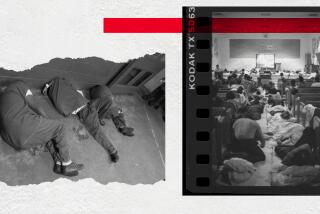Mixing Patients, Inmates a Risk, Report Says
- Share via
Violent jail inmates treated at County-USC Medical Center are routinely assigned beds alongside regular patients, posing a danger to the public and a serious escape risk, according to a county grand jury report released Friday.
Titled “A Disaster Waiting to Happen ... ,” the report calls for an immediate end to the practice that assigns murder suspects and inmates charged with sexual assault to poorly secured areas of the county-run hospital.
Some inmates classified by jailers as escape risks have also been put in general-population wards rather than the heavily secured jail facility on the hospital’s 13th floor. The result has been a succession of escape attempts, at least two of which were successful, the report said.
“The policy of mixing patients and inmates every day exposes thousands to [potential] grave bodily harm and death,” the report said.
County health officials acknowledged the practice but said they were unaware of any inmate assaults on other patients or hospital staff in the open wards.
“Obviously, patient safety is our No. 1 concern in the hospital, and we believe we operate in a safe environment,” said John Wallace, a spokesman for the Department of Health Services.
The report blames the problem on a lack of specialty medical services at the county jails and a shortage of nurses willing to work in the hospital’s jail ward. Although the ward can accommodate up to 35 inmates, Wallace said it usually has enough nurses to treat only 18.
The problem is likely to worsen when the hospital moves to a smaller building in 18 months.
Health officials are examining ways to encourage more nurses to work in the jail ward, Wallace said. But he said the ward is unable to offer the type of specialty treatment for inmates that other wards, such as the burn and intensive care units, can provide.
“You’re never going to be able to get all inmates out of the general-population wards, but we can do a better job,” Wallace said.
The civil grand jury serves as a citizen watchdog panel by investigating local government agencies. It evaluates how public money is being spent, examines conditions at jails and investigates social service agencies. Although the grand jury can recommend changes, it is an advisory body with no enforcement power.
The grand jury’s report offered an alarming view of the way inmates are assigned hospital beds. Because of the nursing shortage, beds always go empty in the jail ward, where about 10 sheriff’s deputies are stationed to deal with combative inmates and search for weapons and drugs. The ward is locked to prevent access to visitors, telephones and contraband.
But inmates assigned to other parts of the hospital are easily accessible to visitors, including friends who might try to help them escape, the report said. Inpatient inmates wear ankle cuffs attached to their bed frames by chains about 8 feet long -- not short enough to prevent physical contact with roommates. Two deputies check on the inmates hourly.
By comparison, state prisoners in general-population medical wards are monitored around the clock by at least one prison guard, said a Department of Corrections spokeswoman.
At County-USC, medical staff and other patients aren’t told what crimes the inmates committed or are accused of, the grand jury said. Looking at 34 days of records from last year, the grand jury found 496 inmates assigned to open wards, including 24 convicted of or charged with murder, 30 accused of sexual assault and 33 more convicted of or charged with other serious assaults.
The comparatively lax security has offered hope to inmates seeking to escape. Over the last several years, authorities have foiled several escape attempts by inmates in general-population wards. But two succeeded.
In one, an inmate slipped out of his leg chains during a CAT scan. In another, a sheriff’s deputy found just the ankle chain on the floor of a ward.
Those escapes occurred in 2000 and 2004, said Sheriff’s Chief Marc Klugman, adding that the department does not have the staff to better monitor inmates housed outside of the jail ward. But Klugman said his agency is taking steps to reduce the number of inmates in general-population wards.
Inmates are currently sent to the hospital even for minor treatment, such as removal of stitches for simple cuts. The department plans to train nurses so that they can treat such minor injuries in the jails, said Klugman, who heads the department’s Correctional Services Division.
In addition, sheriff’s officials intend to start a “telemedicine” program this summer, allowing doctors outside the jails to diagnose and treat inmates via video conferencing. And the department is setting up specialty clinics in which doctors visit the jails, reducing the number of inmates who need to leave for treatment, he said.
“It’s a smart way to do business: Move one guy instead of a whole bunch of inmates,” Klugman said.
More to Read
Sign up for Essential California
The most important California stories and recommendations in your inbox every morning.
You may occasionally receive promotional content from the Los Angeles Times.











